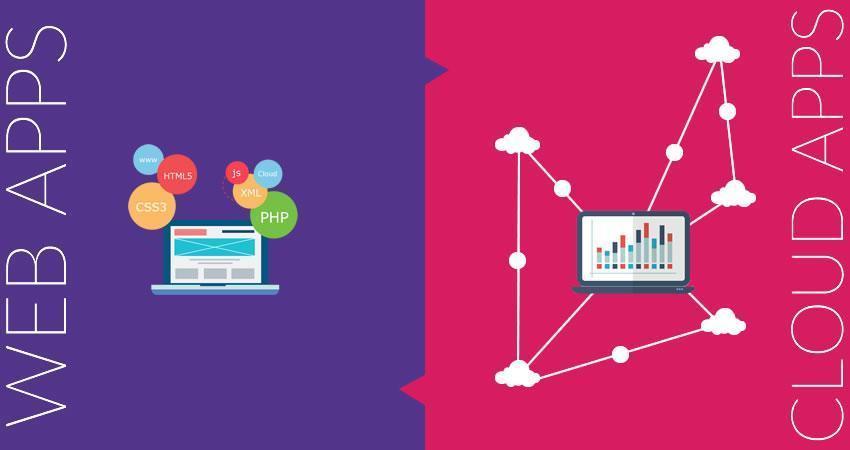The line between a cloud app and a web app is very blurry for most people, mainly because they have a lot of similarities, not to mention, are not formally defined. It explains why most people keep using the terms interchangeably. However, if you consider the user experience, integration, and scalability, there are significant differences between the cloud app and web app.
Users are yet to understand that just because an application runs on the web, does not automatically make it a cloud app. Without this clarity, it is hard to understand what the differences between the two applications are, and how to capitalize on each one of them for the benefit of your business. In this article, find more information on all you need to know about the cloud and web apps and look for a way you can leverage cloud apps for richer user customization experience and seamless integration.
Web Apps
Web apps are exclusively designed for use on web browsers. The web application is developed through a combination of a server-side script like ASP and PHP, and client-side scripts like HTML, JavaScript, and Adobe Flash. This traditional desktop app is virtually accessible from anywhere via the web browser.
Web applications are typical for users online, with examples ranging from electronic banking to online shopping. In another angle, you can include Facebook in the web app category. Different from cloud apps, web apps can only be operated with an active internet connection. Such other examples include Wikipedia, Amazon, and YouTube since they require a continuous connection to work correctly.
Ideally, the web-based application uses a primary communication protocol known as HTTP. Any processing involved in the web applications can only be done over the internet using the external server. The web-based apps essentially encompass all the applications that can communicate with the user via HTTP, including spreadsheet applications, Flash games, and word processors, among others.
Cloud Apps
A cloud app can be looked at as an evolved web application. Technically, the cloud app operates through the cloud and has some characteristics of both pure desktop apps and pure web apps. Even though it is also used a lot in accessing content over the Internet as with the web apps, it is not totally dependent on a web browser to function. Cloud apps are expected to work offline and synch in the background when the internet is restored. The information architecture in this model is about storing data on a cloud. Other than that, several characteristics define the cloud app. Among them:
- Data can be cached locally – HTML5 offline caching features to enable the app to perform even without an internet connection
- Inherently scalable
- Can be used from a web browser as a customizable, multi-tenancy cloud app. However, most times, the web-interface is used as an alternative.
- Can also be used from custom-built applications installed on internet-connected devices, for example, desktops and mobile phones
- Has support for different user requirements, such as data security, data compression, data backup cloud app, and data backup schedule
Since the cloud computing world is quickly evolving, people seeking to become experts in this area require AWS cloud certification training and Udemy as well as a lot of options for you to choose from for the AWS Cloud training. With that training, you can swiftly handle the different cloud apps without too much hassle, including Dropbox, Mozy, Evernote, Sugar Sync, Salesforce, among others. Notice that other examples heavily rely on cloud technology, especially web email like Google, Yahoo, Microsoft Hotmail, among others.
Over and above, the most distinguishing factor between the web apps and the cloud apps is the multi-tenancy to support various requirements and needs for consumers, which is not true for web apps.
The Move to New Technology
This new era of technological sophistication demands several changes in different industries of life. Business owners and service providers cannot remain stuck on one concept and overlook the changes that technology is introducing regarding cloud technology. With concerns over cybersecurity and data breaches, there is an absolute competitive advantage that arises from having cloud apps for your company.
Fortunately, there is a way for a web application to evolve into a cloud app, even though not all web apps are cloud apps. There are rich development platforms and frameworks to choose from when looking to move into the improved cloud app space. Even so, if you are a service provider hoping to evolve your web app into a cloud app, the applications must exhibit particular properties to qualify:
- True multi-tenancy to support various requirements and needs for your consumers
- Considerable support for virtualization technology. This plays a very significant role in cloud era applications. If your web applications are not built to support this, then they should be re-engineered to do so
Conclusion
Generally, both apps are very advantageous to businesses. In fact, you would be surprised to know that today, most of the Web-based applications have become a part of cloud computing. The reason is that most companies prefer saving their data on the cloud as a safety measure. It is therefore very safe to say that cloud apps are web apps in the sense that they can be used through web browsers.
It is not to mean that service providers have not capitalized on the advantages brought about by pioneering web app building framework technologies. However, not all web apps are cloud apps, and neither are all web apps necessarily optimized for building new apps for the cloud era. The reason is that cloud apps offer more functionality and customization than would web apps. For a web app to qualify as a cloud app, it has to provide support for virtualization technology.

